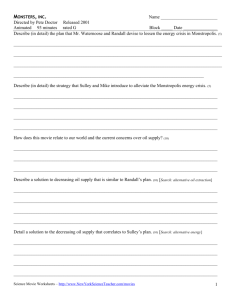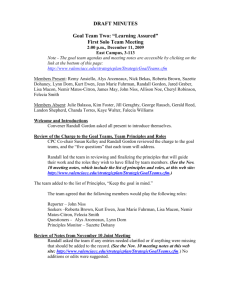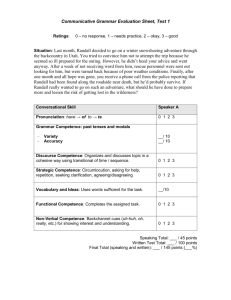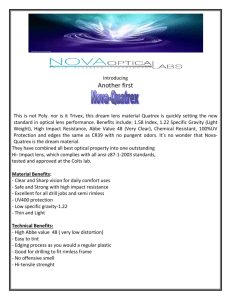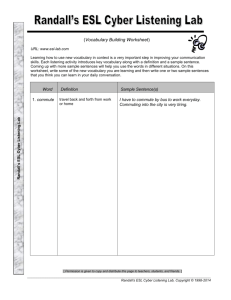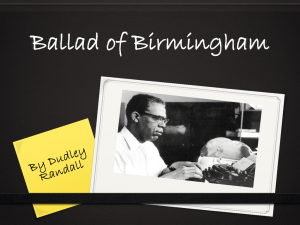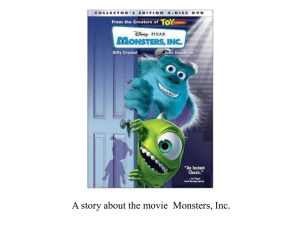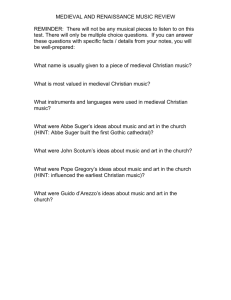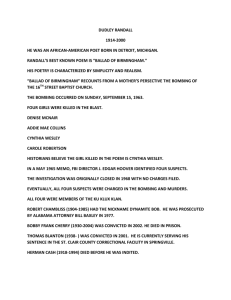Groping for Answers
advertisement
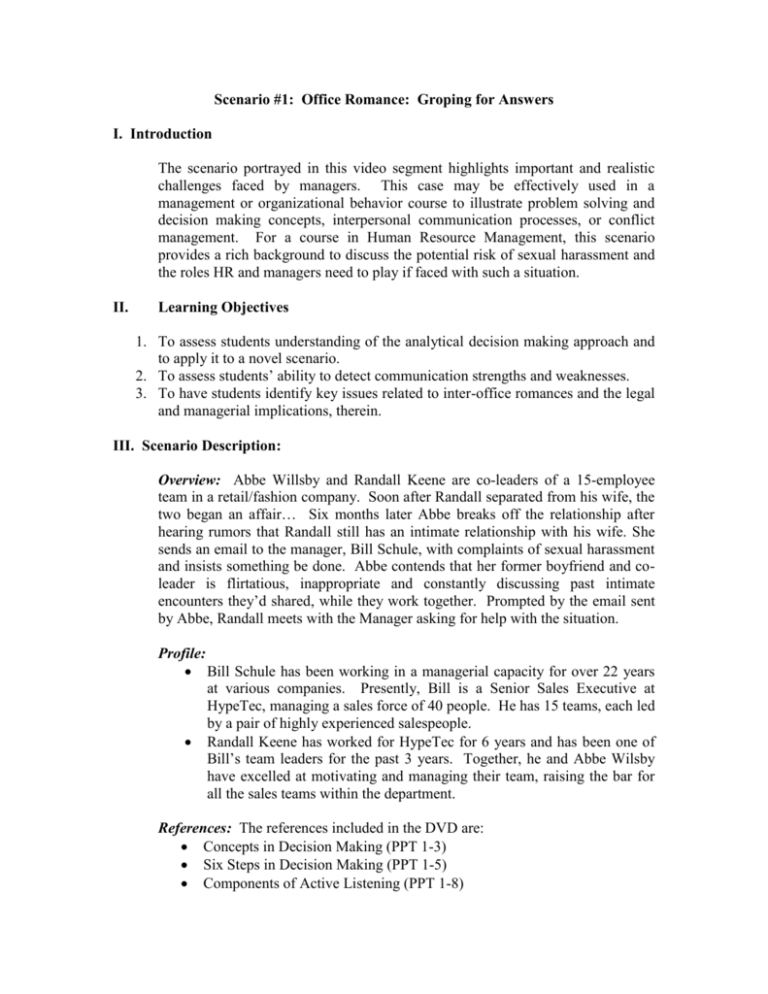
Scenario #1: Office Romance: Groping for Answers I. Introduction The scenario portrayed in this video segment highlights important and realistic challenges faced by managers. This case may be effectively used in a management or organizational behavior course to illustrate problem solving and decision making concepts, interpersonal communication processes, or conflict management. For a course in Human Resource Management, this scenario provides a rich background to discuss the potential risk of sexual harassment and the roles HR and managers need to play if faced with such a situation. II. Learning Objectives 1. To assess students understanding of the analytical decision making approach and to apply it to a novel scenario. 2. To assess students’ ability to detect communication strengths and weaknesses. 3. To have students identify key issues related to inter-office romances and the legal and managerial implications, therein. III. Scenario Description: Overview: Abbe Willsby and Randall Keene are co-leaders of a 15-employee team in a retail/fashion company. Soon after Randall separated from his wife, the two began an affair… Six months later Abbe breaks off the relationship after hearing rumors that Randall still has an intimate relationship with his wife. She sends an email to the manager, Bill Schule, with complaints of sexual harassment and insists something be done. Abbe contends that her former boyfriend and coleader is flirtatious, inappropriate and constantly discussing past intimate encounters they’d shared, while they work together. Prompted by the email sent by Abbe, Randall meets with the Manager asking for help with the situation. Profile: Bill Schule has been working in a managerial capacity for over 22 years at various companies. Presently, Bill is a Senior Sales Executive at HypeTec, managing a sales force of 40 people. He has 15 teams, each led by a pair of highly experienced salespeople. Randall Keene has worked for HypeTec for 6 years and has been one of Bill’s team leaders for the past 3 years. Together, he and Abbe Wilsby have excelled at motivating and managing their team, raising the bar for all the sales teams within the department. References: The references included in the DVD are: Concepts in Decision Making (PPT 1-3) Six Steps in Decision Making (PPT 1-5) Components of Active Listening (PPT 1-8) The Communication Process (PPT 1-9) Back History: Unbeknownst to Schule, Willsby and Keene had been engaged in a serious office romance for the past 6 months. Their romance had little effect on the office environment – the pair had gone from productive team leaders to productive team leaders in love, without any disruption……until the affair ended. A week of hostility and anger permeated the Willsby-Keene team, with a huge drop in productivity reported at the end of a 2-week period. Willsby had broken off the affair because Keene was still involved with the wife from whom he had supposedly separated. Willsby was adamant that the breakup was not the problem – she was a professional woman and any woes of heartbreak or betrayal were not going to interrupt her performance in any way. The problem was that Keene was harassing her throughout the workday, with lots of sexual innuendo, reference to their past intimacies, sexually charged emails, and veiled threats that if she didn’t “go back to him”, he would have her tossed out of their department. Willsby sends an email to Keene, cc-ing Schule, that annotates and lists the instances of harassment, excerpts from emails etc… She is insisting that Keene relocates to another team, or she will be filing a suit of sexual harassment against Keene and suit of a hostile environment against Hypetec. Scene Set-up: Keene receives the email before Schule and barges into his office. Scene Location: Schule’s office, Hypetec Wear; Tuesday morning 8.45am The Meeting - Summary: Randall walks into Bill’s office unannounced clearly agitated over the email he just received from Abbe. Randall begins to explain the situation and Bill immediately expresses concern over the use of company email for personal matters. Randall acknowledges this concern but continues to plead his case by expressing that Abbe was being irrational and should be removed from the department. Bill states that he wants to refrain from making any decisions until he has a private discussion with Abbe and talks things over with the Human Resources department. His primary motive is to ensure productivity of the team doesn’t suffer. He indicated strong disappointment with Randall for engaging in the office romance. Afterthoughts – Summary: Bill thinks that it is entirely possible to prevent litigation at this point. He plans to do some more investigation but believes that a solution can be agreed to by all parties. He reinforces his position that he needs to talk to Abbe and get the other side of the story and recommends that Randall not interact with Abbe at all until the situation gets resolved so that it doesn’t get worse. Bill does not feel that it was too soon to mention likely possible outcomes because they were outcomes typically outlined in organization’s policies (e.g., termination, transfer). Bill states that he feels that at a minimum the two leaders will be separated because they cannot continue to work together. Bill’s major concern with email is that it’s not secure and can be sent to many people and not be factual. Dossier: The specific artifacts included in the DVD are: 1. Willsby’s email (August) 2. Photograph showing Randall touching Abbe 3. Randall’s “threatening” email (July) IV. Discussion Questions: The References and related Discussion Questions may be found in PowerPoint slides 1-1 to 1-12. Learning Objective #1: To assess students understanding of the analytical decision making approach and to apply it to a novel scenario. 1. Would this situation be an example of programmed or non-programmed decision making? Why? (PPT 1-2 &1-3) Student’s responses will vary – focus should be on their thought process and justification rather than on which one they picked. It may depend on how often a manager has these situations. While this is probably not a frequent occurrence, the organization should have a lot of information to provide guidance on what to do. The employee handbook, dating policy, sexual harassment policy, etc should help the manager and HR follow the appropriate steps. However, the situation is unpredictable in that it is unclear if this can be resolved peacefully or if Abbe may pursue legal action. Therefore, both the manager and HR have to be very careful and thoughtful how they handle this situation and the solution they come up with. 2. What would be an example of a satisficing decision in this scenario? What consequences/benefits would this approach have? (PPT 1-2) Students answers will vary. Any answer that is not mutually agreeable to HR, Abbe, Randall, and Bill could pose serious problems later. For example, a short term solution that minimizes disruption, may not fully address the problem which could arise again. 3. What is Bill’s greatest concern? A. Productivity. B. Liability. C. Morale. Bill seems to be most concerned about productivity and is downplaying the likelihood of a lawsuit. This may be an effective approach to not exacerbate the situation. However, the potential legal liabilities of Randall’s behavior should be made clear to him by either Bill or HR. 3. Assume you are Bill and you decide to use an analytical (or rational) decision making strategy to handle this situation (PPT 1-4 & 1-5). The analytical decision making approach involves the following steps: 1. 2. 3. 4. 5. 6. Recognize need for decision Define the problem Generate alternatives Evaluate alternatives Implement a solution Get feedback Describe in detail the specific actions you would take for each step. Be sure to address the following questions in your answer: a. Who would you talk to? b. Where would you go for more information? c. What relevant policies, procedures, laws are relevant here? Student’s answers will vary. It is important that they carefully think through all the options after conducting some research and gathering information (e.g., company’s policies, legal implications). They should describe some process for getting feedback that the implemented solution is working so corrective action can be taken, if necessary. Note: The following “pop-up questions” may be found on PPT 1-6 4. Bill’s first step should be: A. Call Abbe. B. Call HR. C. Document Meeting. Bill plans to call HR first for advice and then discuss the situation with Abbe. HR will probably coach Bill with regard to how to discuss the issue with Abbe. Since Bill manages Abbe, it seems wise to talk to her about the potential of continuing to work together or to make an alternative, mutually agreeable work arrangement. Soliciting her opinions will make her more likely to go along with the final decision. 5. Randall wants to hear Abbe’s side. Bill should: A. Tell him. B. Be confidential. C. Meet as group. Bill should not disclose information he receives from Abbe to Randall. At some point in the future, it might make sense to meet as a group, but currently, the individuals involved are probably too sensitive and emotional for it to be a productive group meeting. 6. Bill is discussing possible outcomes. A. It’s too early B. It’s appropriate C. It’s HR’s job Bill does not feel that it was too soon to mention likely possible outcomes because they were outcomes typically outlined in organization’s policies (e.g., termination, transfer). Because Bill is their manager, he should be the one to own the decision on the outcome. Having HR make the decision, may not be perceived to be in the Sales organizations’ best interest and may not be as accepted as it would be coming from Bill. Learning Objective #2: To assess students’ ability to detect communication strengths and weaknesses. 1. Evaluate Bill and Randall’s active listening and communication skills (“Components of Active Listening” and “The Communication Process”; PPT 1-7 to 1-9). What did each do effectively? How could they have improved? Support your answers with the specific behaviors you observed. Randall interrupted Bill frequently, indicating that he was not really listening to his point of view. Randall also would not accept the fact that there was another side to the story. Instead of listening, he spent time defending his position and thinking up arguments to refute Bill to ensure he got what he wanted. Bill maintained his composure, was not flustered by Randall’s agitation. He empathized with Randall’s viewpoint without agreeing with it. While noting his dissatisfaction with what had happened, he withheld making a final evaluative judgment until more information was collected. 1. Randall’s agitated. What should Bill do? A. Stop Meeting. B. Hear him out. C. Call Abbe in. Discuss each option in terms of it’s relative effectiveness towards promoting supportive, professional communication. Option B: Hearing him out, while attempting to calm him down would prevent the situation from escalating. Options A and C may serve to create more disruption and tension between the parties. 2. Abbe and Randall chose to communicate about their personal relationship via email. What are the disadvantages of using this communication medium for this purpose? What would have been a more effective way for Abbe and Randall to communicate? (PPT 1-10) Email should not have been used for personal business according to the company’s policy. This puts the company at risk if email of this nature was distributed to the general public. Tone is hard to convey in emails so it is more likely to result in a miscommunication especially when dealing with a personal, emotional situation such as this. A violation of company policy (office romance) is now documented and tangible evidence exists due to their communication via email. Abbe and Randall probably would have had a more productive communication if they had met face to face so that body language, voice inflection and other non-verbal cues could have helped them interpret each other’s meaning better. 2. What is the concern about email use? a. It’s not secure. b. It’s not efficient. c. Easy to misinterpret. Bill’s major concern is that it is not secure and that the content could be misinterpreted because non-verbal cues are not present. He is also concerned that the email could be received outside of the organization and be damaging to the company’s image. Learning Objective #3: To have students identify key issues related to inter-office romances and the legal and managerial implications, therein. 1. What guidance is HR likely to provide to Bill? What future actions are Bill’s responsibilities? What actions should HR take? (PPT 1-11) HR should provide guidance in terms of the dating policy the organization has and the sexual harassment policy. Appropriate disciplinary action should be taken if it is written in a policy by Bill as their direct manager. Bill definitely needs to talk to Abbe about her side of the story. Ask her what solution would be amenable to her that preserves the goals of the department. Convey that the interoffice relationship is not condoned and that it threatens the ability of the group to achieve their goals. HR may want to interview Abbe and Randall to diffuse the situation and reinforce the importance of adhering to the organization’s sexual harassment and dating policy. 2. Abbe and Randall were co-leading a team. Does this situation pose the potential for a lawsuit based on quid pro quo or hostile work environment sexual harassment? Why? (PPT 1-11) Because they did not have a supervisor/subordinate relationship in which one made employment-related decisions (e.g., firing, raises, promotions) that affected the other, this situation would more likely fall under the hostile environment theory of sexual harassment. Abbe would have to demonstrate that Randall’s actions created an abusive working environment. The fact that Abbe had been a willing participant in a prior relationship would make her case tougher to make. 3. Should the fact Abby and Randall were involved in a relationship be reflected on their performance evaluation? Who should be held accountable for the lower productivity of their team? (PPT 1-12) If disciplinary actions were taken, it is probably not necessary to restate the specifics of the situation in the performance review. At that point, it is more important to focus on how effectively they have met their performance objectives. Therefore, if they are held accountable in their performance planning document for the team’s performance, then their performance evaluation should reflect the fact that the group’s performance declined (assuming the performance of the team didn’t rebound).
